In August 2018, Kepa Arrizabalaga made the move from Athletic Club to Chelsea for a record £72 million. The price paid by the London side is, to this day, the highest price paid for a goalkeeper. And with such a hefty price tag comes a burden of responsibility. Unfortunately for Kepa, his time at Chelsea hasn’t quite gone so smoothly.
In preparation for this magazine piece, I decided to consult some Chelsea fans on Twitter. While some believed their Spanish shot stopped started his tenure at Stanford Bridge promisingly, his form this season has been, in their words, abysmal. This piece will aim to look at some of Kepa’s biggest ‘mistakes’ and break down what happened, what he could have done differently and whether he has really been as poor as people say.
The statistics
Finding relevant statistics on goalkeepers isn’t an easy task. The whole ‘goals conceded versus shots faced’ argument is flawed. In fact, in my opinion, it is much more a reflection on a team’s defence than the goalkeeper itself. If a goalkeeper stops just 25% of the shots he faces, but 90% of the shots faced are within the six-yard box, perhaps questions need to be asked about the players in front of him?
I have similar reservations about people who look at clean sheets as being an indicator of a goalkeeper’s talents. The fact that golden glove awards are handed out on such a basis is, to me, ridiculous. It seems like a cop-out for those who don’t truly understand the intricacies of the goalkeeping position. With that being said, FBref.com does provide some interesting numbers for us to look at. There are a few worrying statistics that Chelsea supporters need to be aware of.
The first is Post-Shot Expected Goals minus Goals Allowed (PSxG+/-). Positive numbers in this category indicate that a goalkeeper has a better ability to saving shots. Kepa has a score of -4.2 in this category. For context, the goalkeeper with the worst score in this category is Angus Gunn, of Southampton, with -6.0 in 10 games. The highest-ranked Premier League goalkeeper is Martin Dúbravka, of Newcastle United, with a score of +7.2.
When we look at the PSxG+/1 allowed per 90 minutes, Kepa has the second-lowest score. He records a -0.18 in this statistic, with Burnley’s Nick Pope registering a -0.21. Dúbravka is, once again, the best performer in this statistic, registering a +0.30.
When we break down these numbers beyond their averages, Kepa has conceded 32 goals in 24 games. His expected PSxG is 25.8. Dúbravka has conceded more goals (36) in the same number of games (24) but has a PSxG of 42.2.
It is clear that Kepa is conceding more goals than perhaps he should. But let’s take a look at some of his ‘biggest blunders’ to see exactly what went wrong for him. We will handpick a few scenarios from Kepa’s lowlight reel and determine whether the harsh criticism is fair. Spoiler, in some cases it isn’t.
Arsenal – January 21, 2020
Much has been said about one of Kepa’s most recent blunders. When playing Arsenal at Stamford Bridge, the side tied 2-2 despite having a man advantage. One statistic from the match that fans continuously point to is Kepa’s two goals conceded from two shots faced. Now, on its own, that statistic shouldn’t be a criticism of the goalkeeper. It doesn’t take into account the difficulty of the shots faced. Had both shots been from the penalty spot, then it would be difficult to blame the Spaniard.
The first goal Chelsea conceded in the match was more N’Golo Kanté’s fault than Kepa’s. While he could have potentially been a little more patient during the 1v1, the matches second goal was much more preventable. The shot from Héctor Bellerín was well placed in the corner, and while it appears as though it beats an outstretched Kepa, the goal could have been saved.
Just because a goalkeeper is outstretched doesn’t mean they are covering their net with the most efficiency. The mistake in this goal comes down to angles. Before we analyse this goal let’s take a quick look at the moments before and just after the goal is scored.
In the image below we can see Bellerín attempting to take a shot from the edge of the box. Kepa’s positioning isn’t necessarily the problem here. He is capable of saving a shot driven in at the near post and is relatively central in his net in relation to the shooter.
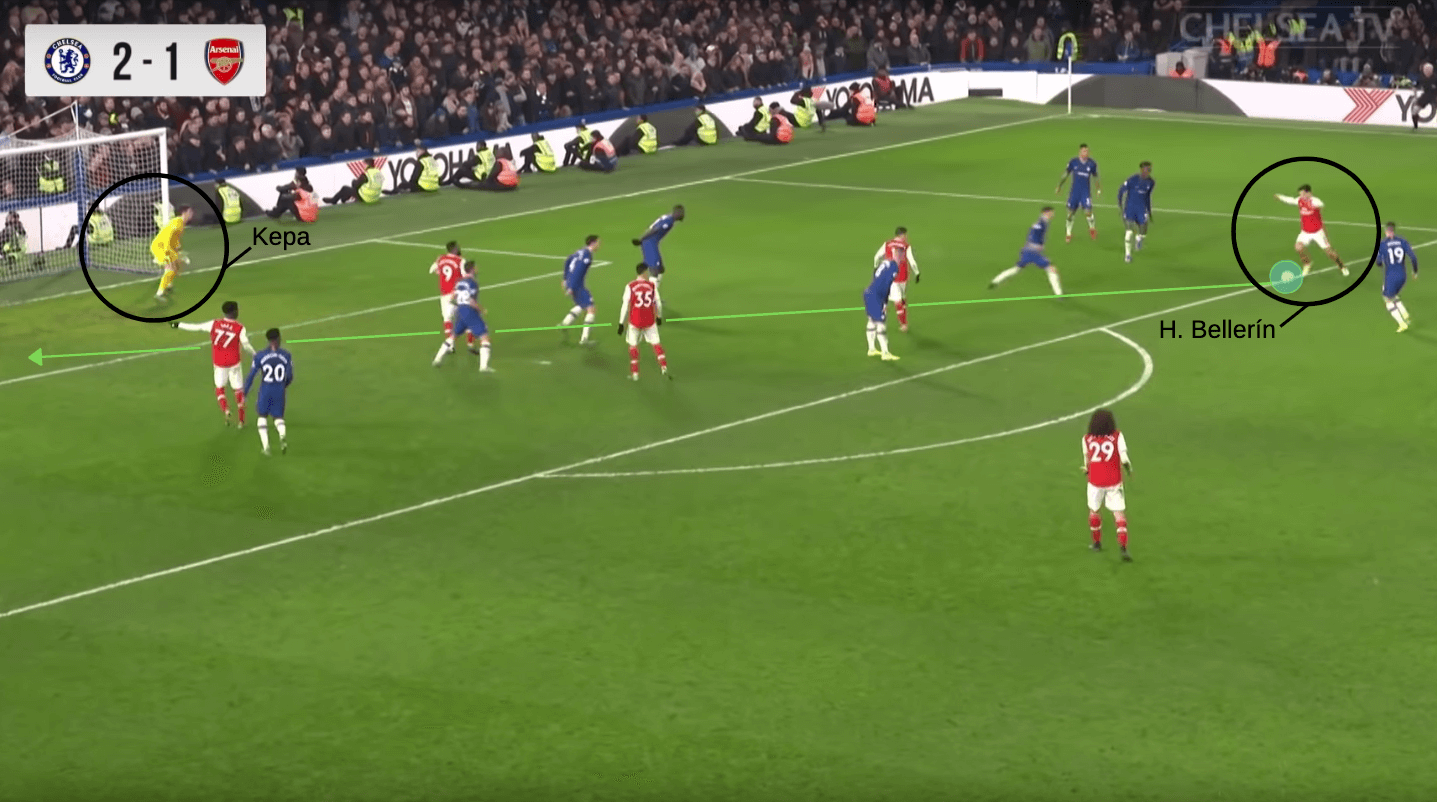
We can see the moment the shot passes Kepa in the image below. As we can see, Kepa is diving backwards in relation to the angle of his set-position. In this image, you can see a green line. This indicates the angle at which I suggest Kepa should have dived at. I will explain my reasoning for this below.
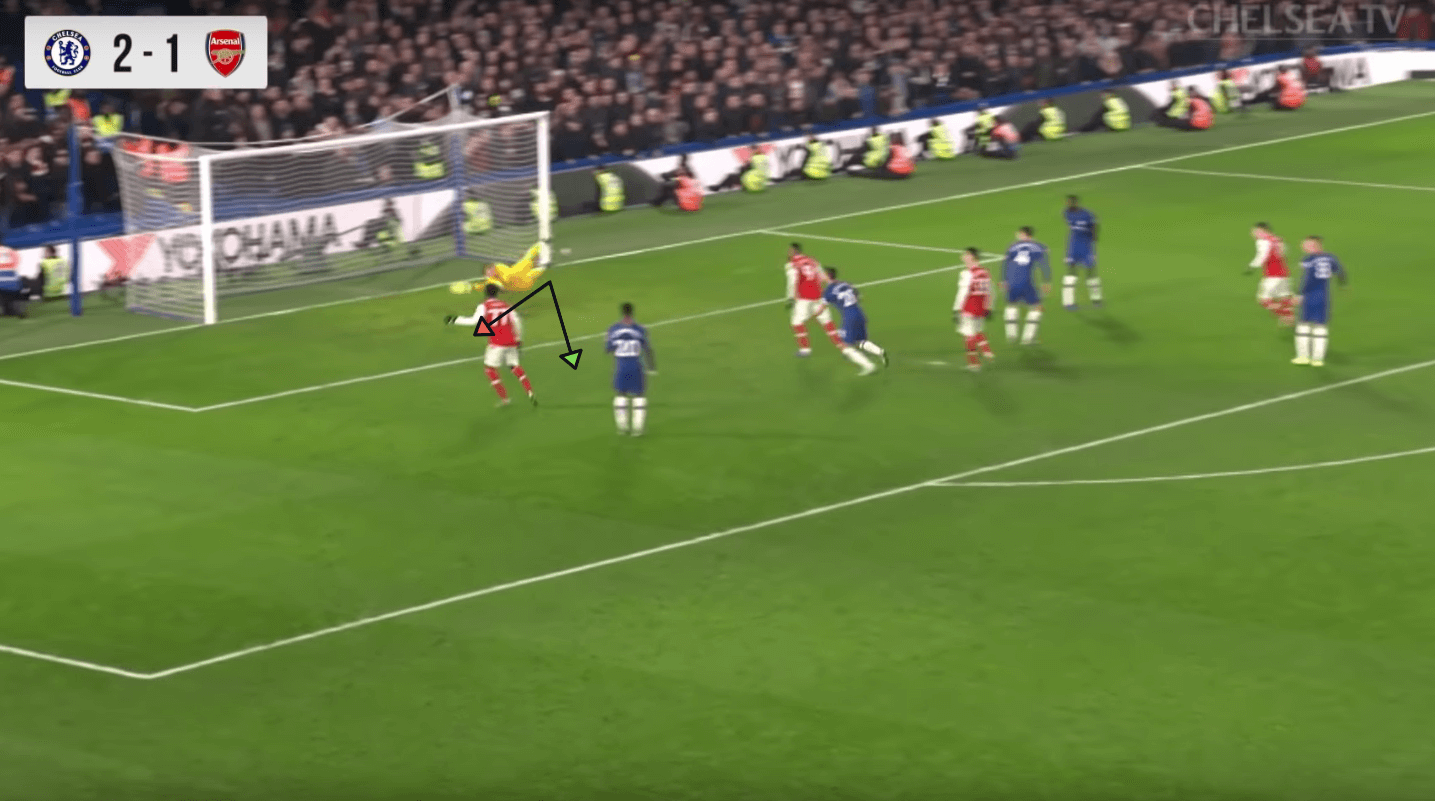
Now, the problem with the angle of Kepa’s dive is that he has an opportunity to take away more of the net from Bellerín if he dives forward. This is a basic skill that goalkeepers learn from an early age, and is the first thing taught by many goalkeeper coaches as the grassroots level. Forward movement is central to the success of almost every action made by a goalkeeper.
In the graphic below we can see how Kepa could have been more successful if had dived forward, instead of diving backwards. The first line shows where Kepa dove, while the second shows where he could have been more successful. As we can see, the path of Bellerín’s shot passes through the second dive, while it moves past the first dive with ease, as it did in the game.
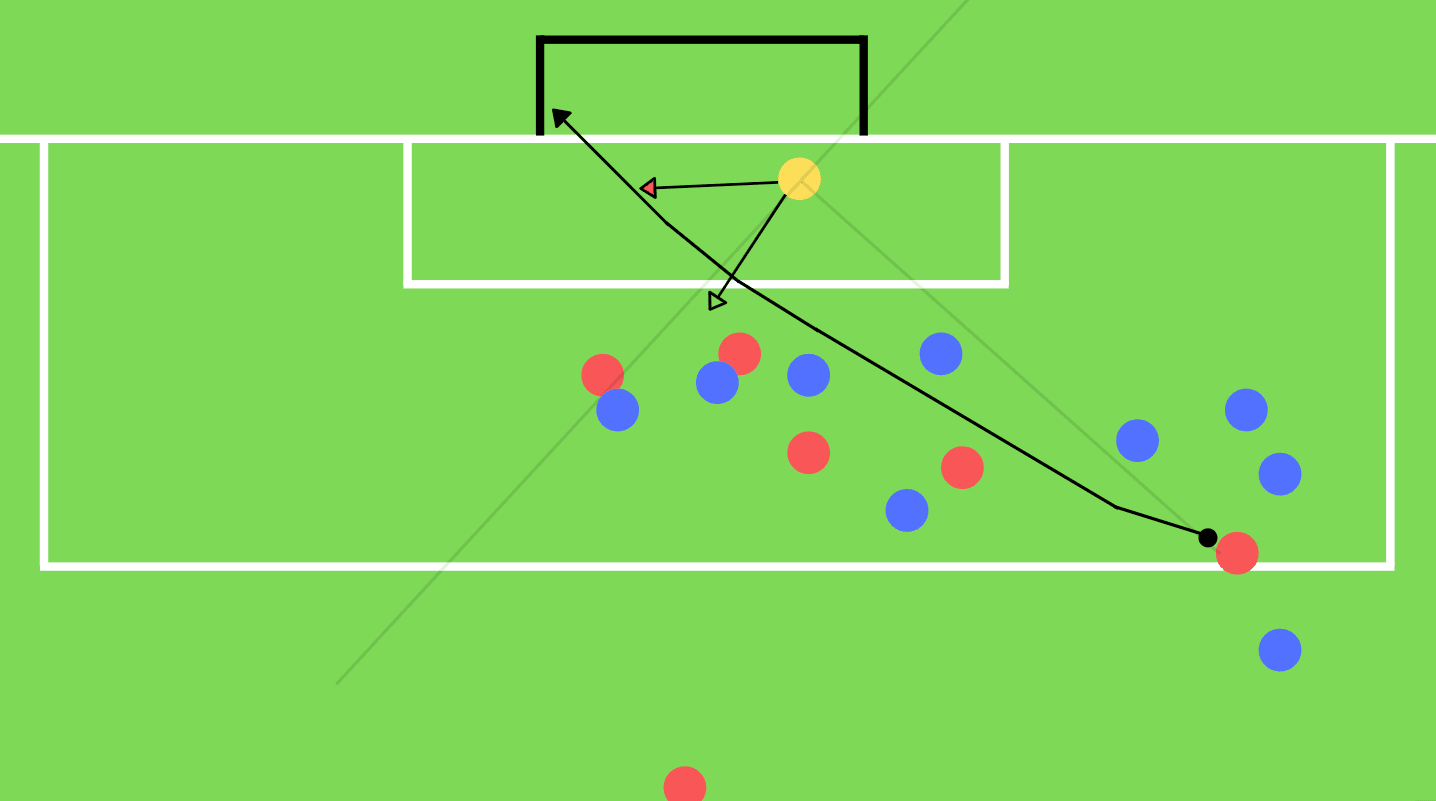
So, if it’s that easy, why would a goalkeeper of Kepa’s quality dive backwards? While only Kepa will know the answer to this, I believe there is a reasonable explanation. It all comes down to where he wants the ball to move after he makes the save. While the first priority of a goalkeeper is to prevent the ball from hitting the back of the net, the second is to ensure that the ball is in the least threatening position after the save is made. The safest place would be in the goalkeeper’s hands and the most dangerous would be back into the centre of the box.
I believe that Kepa dove backwards in an attempt to tip the ball around the post, out safely for a corner. Had he made the save going forward, but failed to catch it, the ball would have dropped inside the box for an Arsenal attacker to gobble up.
Kepa’s step itself also contributed to this poor dive. Rather, his lack of step did. When goalkeepers extend their body to complete a dive, they take a step with their inside foot on a forward 45-degree angle towards the path of the ball. For example, in this scenario, Kepa would have taken a forward step with his right foot and then exploded off the step into the dive. In this instance, however, Kepa didn’t take a step. Instead he shifts his weight onto his right foot and pushes off on it from there.
While this may sound like a small detail to anyone not familiar with goalkeeping, it can have a big impact on the length of the dive. It also provides the goalkeeper with a more powerful movement to push the ball around the post.
So, in conclusion, the biggest mistake made here by Kepa was prioritisation. He was too concerned with where the ball would have landed after he made the save, therefore hindering his ability to pull off the save altogether. He also failed to take a crucial step that would have given him that extra power and distance needed to save the game tying shot.
Ajax – November 5, 2019
Many Chelsea fans point to their 4-4 thriller against Ajax as being a moment of disgrace for Kepa. One of the goals that fans can’t fathom Kepa let in was the third Ajax goal. This goal was credited as a Kepa own goal, however, it was really the brilliance of Hakim Ziyech that caused the goal.
The Moroccan lined up to take a freekick from just inside the field from the corner flag. Many people, Kepa included, expected the midfielder to cross the ball into the box. Instead, Ziyech whipped the ball into the back post, perfectly aimed at the top corner. Unfortunately for the goalkeeper the ricochet off the post, off his face, and into the back of the net.
Much of the criticism thrown at the keeper is that he shouldn’t be beaten from such an angle. In truth, however, it was a brilliant shot. It wasn’t as if Kepa was poorly positioned during the freekick. He was far enough back in his net to save almost any shot on goal, except for the one that eventually went in. Had he been any further back towards his back post, he would have limited his ability to come forward and claim a cross into the box, or even a near-post shot.
Others may claim that Kepa should have stationed a defender on his back post. This, in truth, however, isn’t how Chelsea set up to defend crosses from wide positions. After reviewing Chelsea’s defending of corners this season, Frank Lampard’s side refrain from putting a defender on the front and back post. This is constant, regardless of whether Kepa or Willy Caballero is in goal.
So, while this goal looks like a horrific mistake at first glance, it is hardly fair to blame the goalkeeper. Sometimes you must take your hats off to the goalscorer and applaud the precision of their strike.
But, while this goal may not be the fault of the goalkeeper, Kepa did make a few blunders during this match. The worst of which was the first goal. This goal was scored after Quincy Promes whipped a ball into the box, and appears to travel directly into the back of the net. Unfortunately for Kepa, there is a slight deflection taken off of Tammy Abraham right at the corner of the six yard box. The deflection is enough to take the ball slightly out of the path of Kepa, and into the back of the net. We can see the instance where the touch off Abraham changes the direction of the ball in the image below.
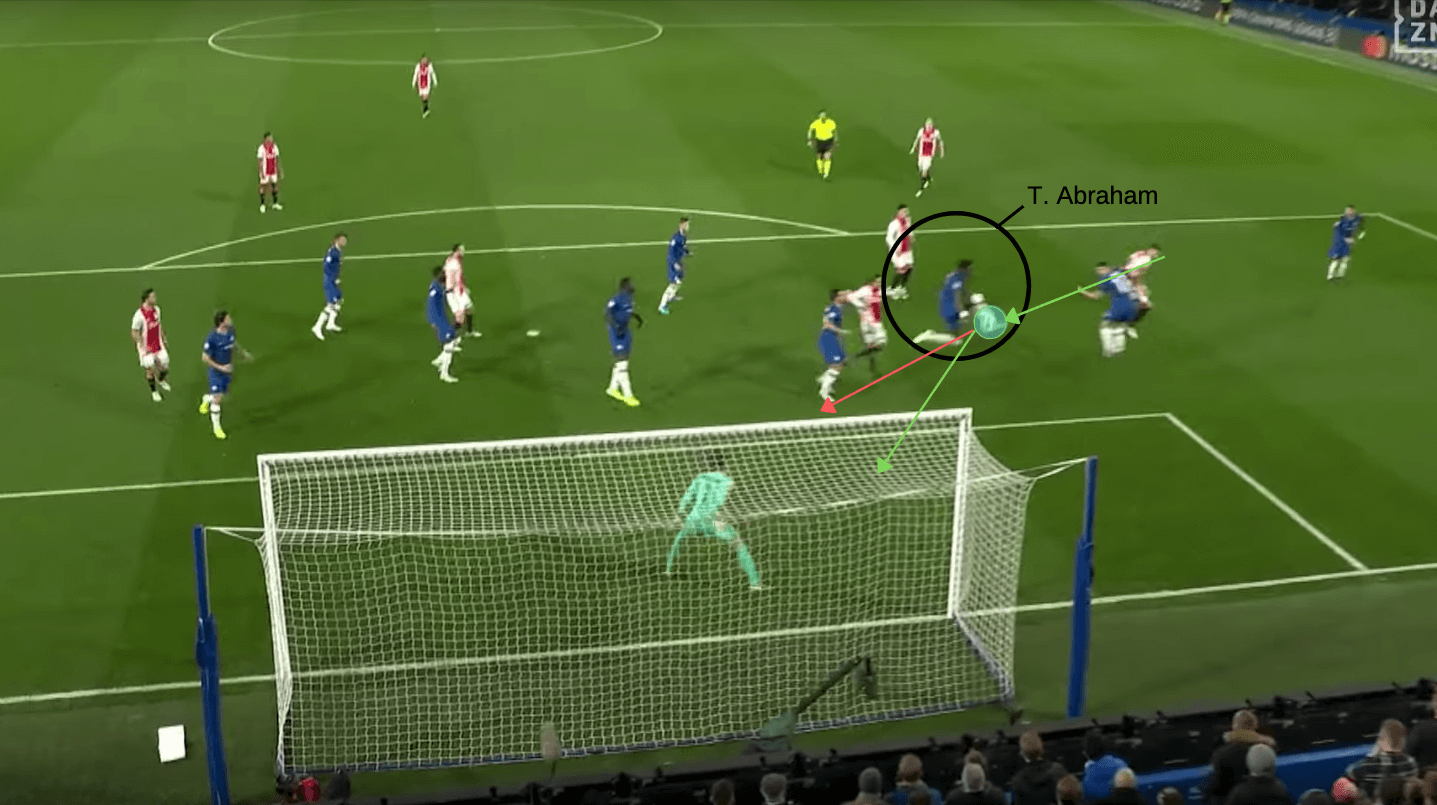
I will admit that when I first saw this goal I assumed it has brushed past Abraham without taking a touch off the player. I even believed this after I saw the highlights. But after slowing the footage down you can see quite clearly the ball guided away from the goalkeeper.
Unfortunately, this deflection doesn’t prevent Kepa from making the save. The biggest thing that hindered Kepa in this scenario was that he was moving at the time the ball made the deflection off Abraham’s leg. As the ball made its way into the box, Kepa readjusted his position to get behind the ball.
Again, but slowing down the footage it is clear that Kepa shifts to his right, but then, right before the ball passes Abraham, shifts his weight to his left. It appears as if Kepa ‘overshot’ his rightward movements and attempted to make a slight movement back to his left.
As soon as he shifts his body weight to the left, the ball takes a deflection, taking it away to his right. And while the shift of body weight is so slight, it does make the save that much more difficult to make. Now, obviously it is difficult to show the exact movements of Kepa in still images, but the image below does show Kepa leaning back towards his left the exact same moment as the ball touches Abraham’s leg.
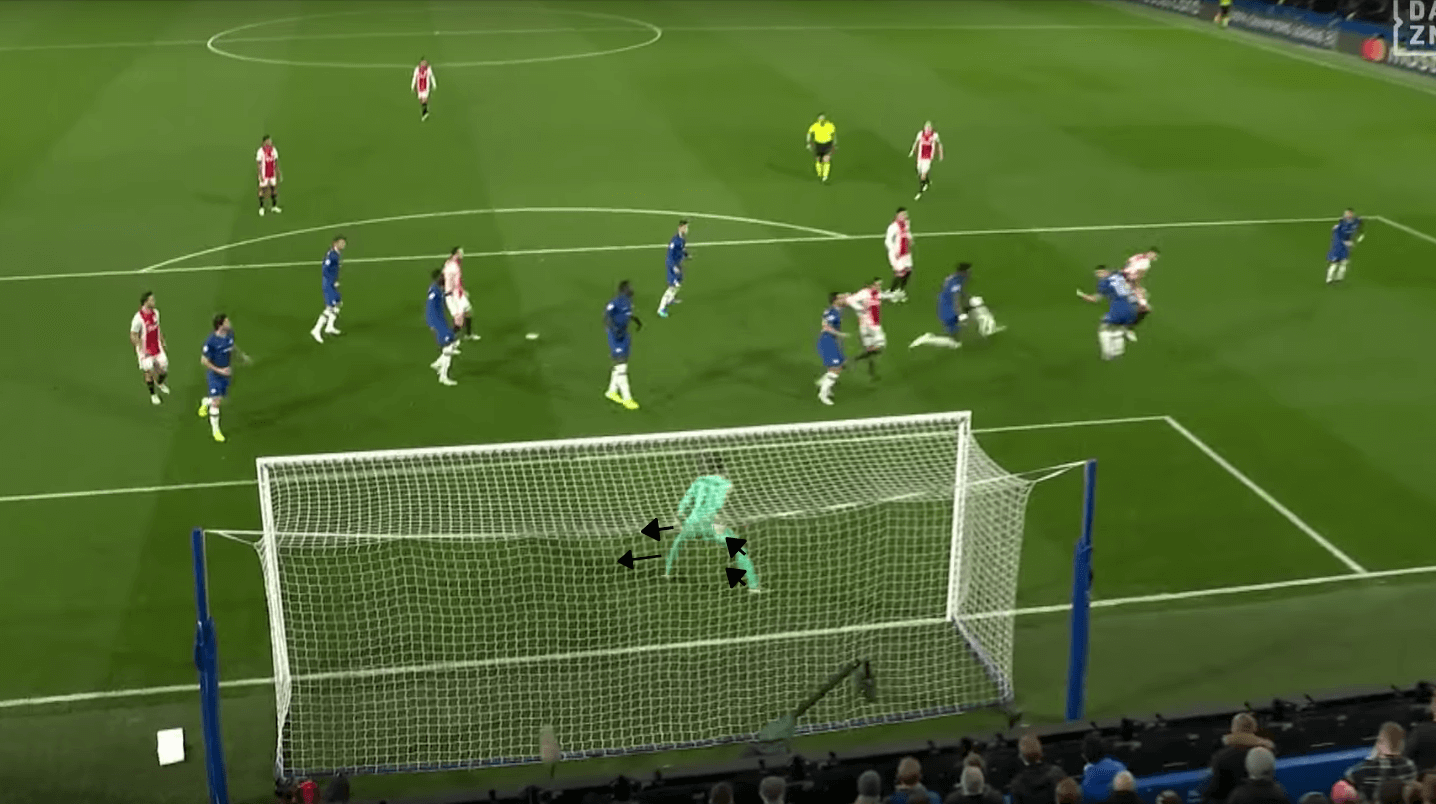
There is a level of anticipation that must be had from goalkeepers. When a ball moves into a crowded box, the keeper must be confident in their set-position and stay laser-focused on the movements of the ball.
While I claim that Kepa could have done better in this scenario, it is a very harsh criticism. As we have shown, the deflection, while small, had significant consequences. One small miss-step from the goalkeeper completely altered his ability to save the shot.
Newcastle – January 18, 2020
This match was a huge blow for Chelsea. Despite bossing 70% of the possession and recording 19 shots, the Blues couldn’t manage to break Newcastle down to score a goal. It appeared as though both teams were willing to settle for a draw before Allan Saint-Maximin whipped in a cross to Isaac Hayden in the 94th minute.
If not for an eruption of Geordie cheers, St. James’ Park would have been filled with groans after Hayden’s header hit the back of the net. While the midfielder did well to rise above his opposition and fire the ball past the Spaniard, we can once again find a few flaws in Kepa’s overall approach to saving this shot.
In the image below we can see Kepa’s set position as the ball hits Hayden’s head. His left leg is slightly behind his right, putting him in a position not parallel to the shooter. This all comes down to basic shot-stopping again.
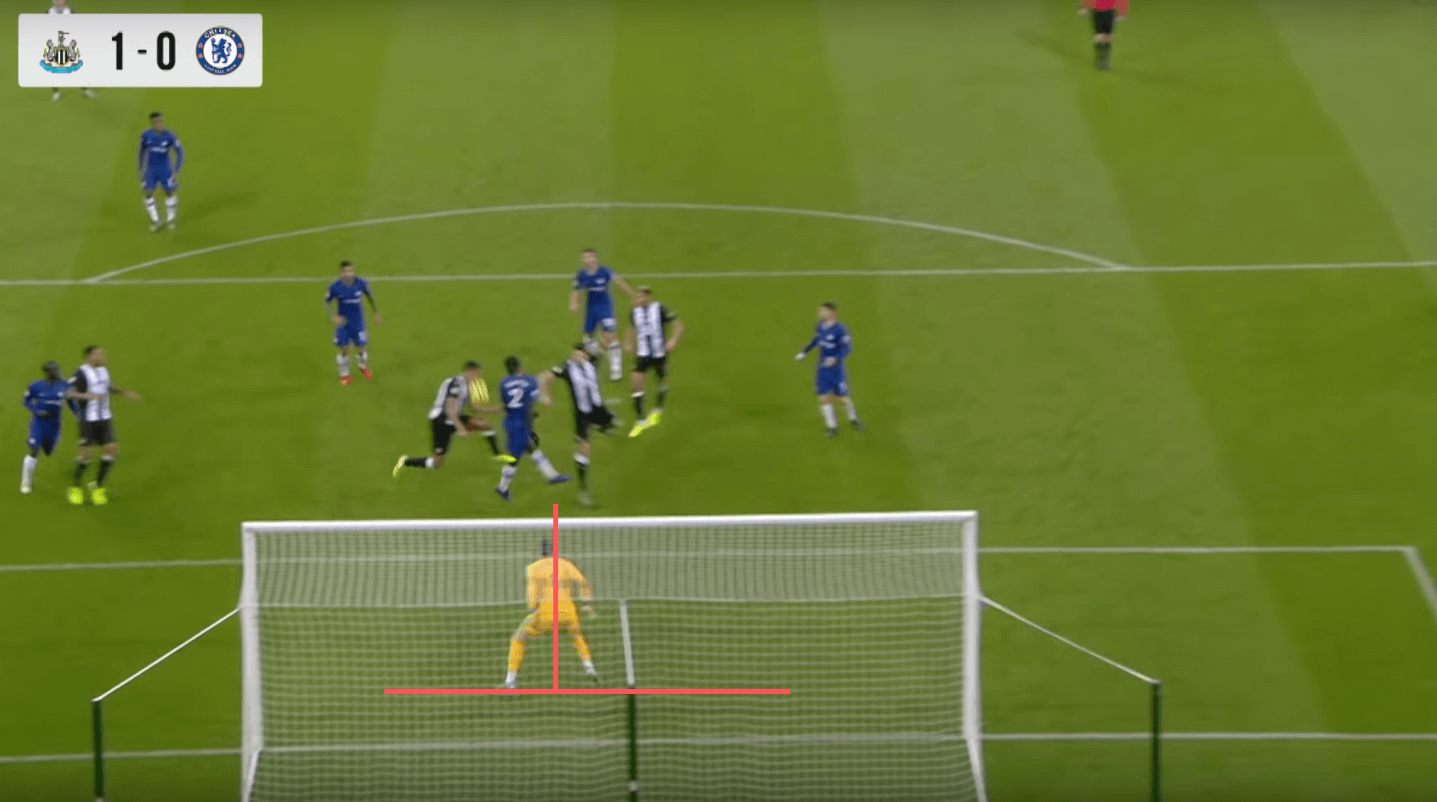
In the first section of this analysis, when discussing Kepa’s attempted save against Arsenal, we discussed the importance of diving forward when making a save. As we can see, from rolling this clip forward, Kepa is diving backwards when attempting to save Hayden’s header.

We can see Kepa make contact with the ball, however, it just passes past him into the net. Had Kepa’s movement been forward in relation to his body and the shooter, there is a much higher chance than the deflection the ball takes off Kepa’s hand is forward also. That’s physics.
So, the save itself is once again, like in the Ajax game, hindered by the goalkeeper’s position right before the ball takes the final touch off the attacker. As the cross comes in Kepa can also be seen attempting to readjust himself to find the perfect spot.
We saw an example of a flustered and confused goalkeeper making a similar mistake when Jordan Pickford conceded a second stoppage-time goal to Florian Lejeune when Everton played Newcastle. The fact both goals were scored by a Newcastle player is completely coincidental, however, it does show how confusion in the box can cause goalkeepers to lose their set position.
But Kepa’s mistake is something that can be so easily fixed. The hardest part in both this and the Ajax goals was the reaction. And, in both scenarios, Kepa managed to get a hand on the ball. Had his set position been better, perhaps he would have done better?
Conclusion
I know what you are thinking; These are just four isolated incidents across the span of a season – what can they tell us about the quality of a goalkeeper who makes multiple saves and lets in multiple goals across the span of a year?
You would be right to question it. However, to look at every incident that Kepa was involved in over the course of the year would be much too time-consuming for a simple scout report. But, by looking at a few of his biggest ‘mistakes’ over the last season, we can begin to understand a little bit more about the reason the goalkeeper has been underperforming.
While we determined the third goal against Ajax was not the goalkeeper’s fault, the other three had one thing in common. Decision making. It is clear that Kepa has the physical ability to make these saves, whether it be the required distance of his dive or the adequate reactions. However, small mistakes made at crucial times have cost him, and Frank Lampard’s tactics, dearly.
We have seen David de Gea, arguably one of the world’s best goalkeepers, make multiple blunders over the last year or so. Confidence can weigh heavily on most players in the modern game. But when it happens to a goalkeeper, the mistakes are amplified tenfold.
When a midfielder turns the ball over because his confidence is low, or a defender misses a tackle because he is in bad form, of course, it can be talked about. However, most of the time an outfield player’s mistakes are only dwelled on when they directly result in a goal. In almost every instance that a goalkeeper makes a mistake, they are punished.
This tactical analysis and scout report isn’t excusing Kepa’s bad form, however. In fact, it’s not even about his confidence at all. Instead, it has attempted to analyse a few individual incidents and provide an objective opinion on what exactly went wrong in each scenario.
Hopefully, for those of you who are unfamiliar with the small intricacies of a goalkeeper’s job, you have learned a few things for when you next watch a goalkeeper make a ‘mistake’ in a game. Instead of pointing blame and moving on, try and understand the whole scenario, and break down all the variables within just a few seconds of action.

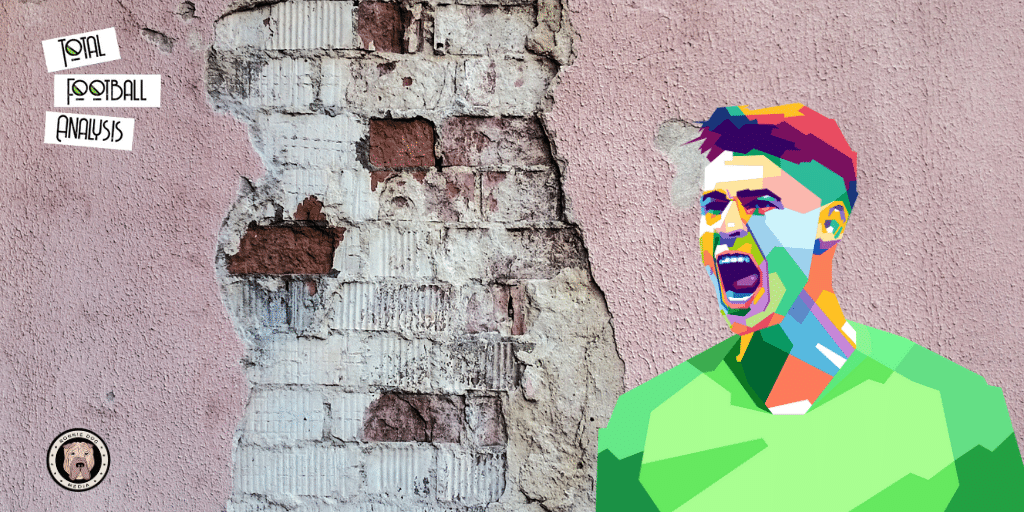



Comments